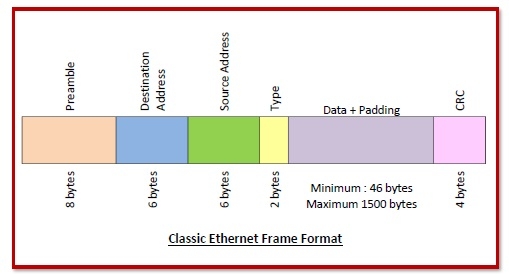
 Data Structure
Data Structure Networking
Networking RDBMS
RDBMS Operating System
Operating System Java
Java MS Excel
MS Excel iOS
iOS HTML
HTML CSS
CSS Android
Android Python
Python C Programming
C Programming C++
C++ C#
C# MongoDB
MongoDB MySQL
MySQL Javascript
Javascript PHP
PHP
- Selected Reading
- UPSC IAS Exams Notes
- Developer's Best Practices
- Questions and Answers
- Effective Resume Writing
- HR Interview Questions
- Computer Glossary
- Who is Who
Architecture of Classic Ethernet
Ethernet is a set of technologies and protocols that are used primarily in LANs. It was first standardized in 1980s as IEEE 802.3 standard. Ethernet is classified into two categories: classic Ethernet and switched Ethernet.
Classic Ethernet is the original form of Ethernet that provides data rates between 3 to 10 Mbps. The varieties are commonly referred as 10BASE-X. Here, 10 is the maximum throughput, i.e. 10 Mbps, BASE denoted use of baseband transmission, and X is the type of medium used.
Architecture
Classic Ethernet is simplest form of Ethernet. It comprises of an Ethernet medium composed of a long piece of coaxial cable. Stations can be connected to the coaxial cable using a card called the network interface (NI). The NIs are responsible for receiving and transmitting data through the network. Repeaters are used to make end-to-end joins between cable segments as well as re-generate the signals if they weaken. When a station is ready to transmit, it places its frame in the cable. This arrangement is called the broadcast bus.
The configuration is illustrated as follows −

Frame Format of Classic Ethernet
The main fields of a frame of classic Ethernet are −
- Preamble: It is a 8 bytes starting field that provides alert and timing pulse for transmission.
- Destination Address: It is a 6 byte field containing physical address of destination stations.
- Source Address: It is a 6 byte field containing the physical address of the sending station.
- Type: It a 2 bytes field that instructs the receiver which process to give the frame to.
- Data: This is a variable sized field carries the data from the upper layers. The maximum size of data field is 1500 bytes.
- Padding: This is added to the data to bring its length to the minimum requirement of 46 bytes.
- CRC: CRC stands for cyclic redundancy check. It contains the error detection information.


